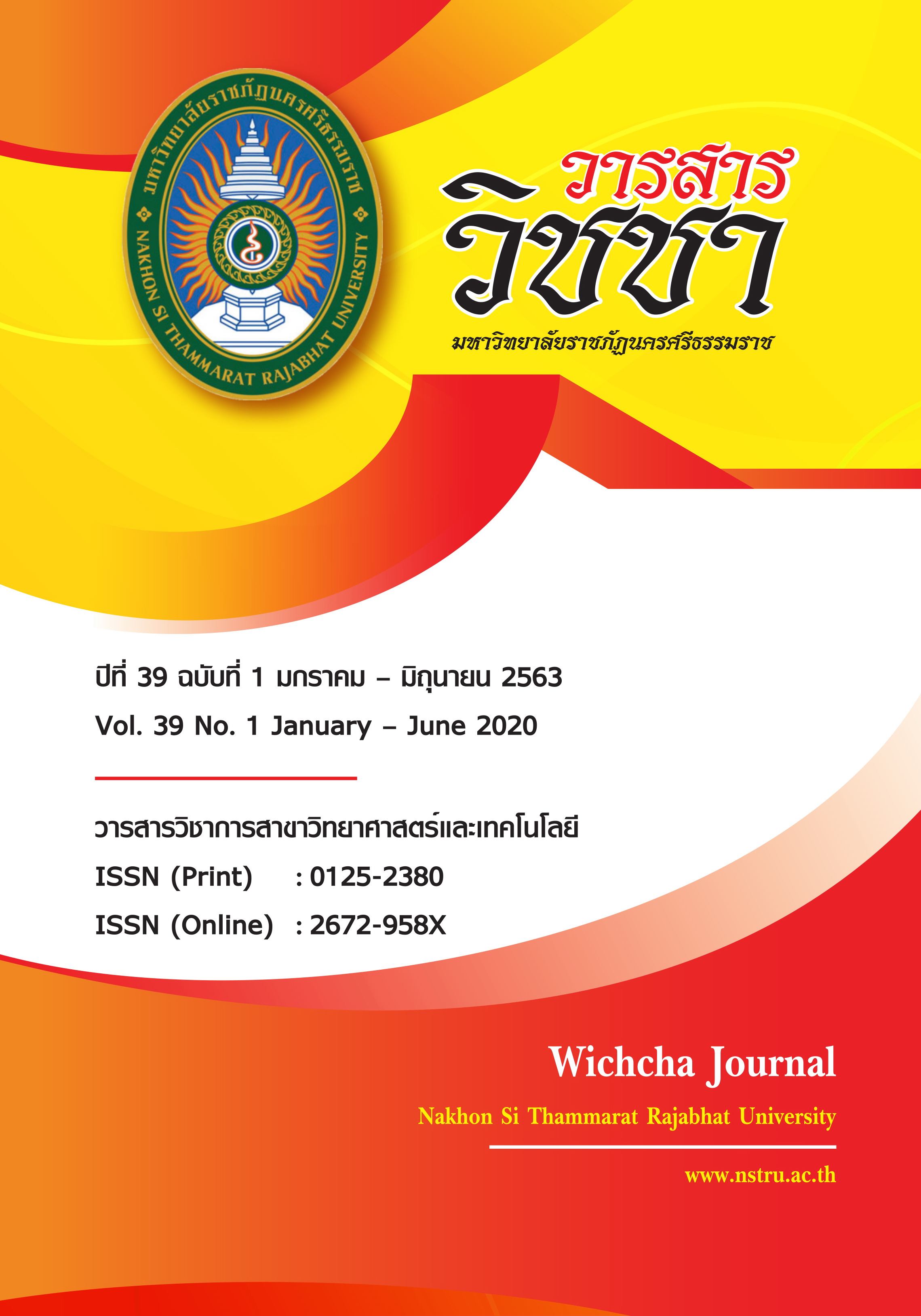The Optimum Condition for Artificial Wood Production from Compression Moulding Process สภาวะที่เหมาะสมสำหรับการผลิตไม้เทียมโดยกระบวนการ
Main Article Content
Abstract
Artificial woods were mixed from rubber and sawdust powder. The research studied the artificial wood moulding temperature (125, 135, 145, and 155oC), composite accelerator (zinc- N-diethyl dithiocarbamate (ZDEC), tetramethyl thiuram disulphide (TMTD), 2-mercapto benzothiazol disulfide (MBTS), N-cyclohexyl-2-benzothiazole sulfenamide (CBS), and N,N-diphenyl guanidine (DPG)) and the mechanical properties of artificial wood with the mixture of sawdust powder (20, 40, 60, 80, 100 phr). It was found that the curing time of artificial wood decreased according to the increasing temperature. All types of accelerators used in this case could be completely moulded to artificial wood at 125oC and 135oC, except for the ZDEC that the moulded temperature could not be higher than 125oC. However, both temperatures were not appropriate for production as it took more than 60 and 30 minutes to complete the product, respectively. For artificial wood with a thickness of 15 mm, the use of MBTS, the mixture of MBTS and DPG, and CBS could be completely molded at 145oC, but for artificial wood with a thickness of 25.4 mm, only MBTS and the mixture of MBTS and DPG can provide the most complete moulding. The mixture of MBTS and DPG provided the highest cure rate index. There were cycle times of 16.45±0.03 minutes and 18.45±0.04 minutes for artificial woods with the thickness of 15 and 25.4 mm., respectively. The amount of sawdust powder in composite materials also affected the mechanical properties of artificial wood. The increase of the wood sawdust increased the stiffness of the wood, with the highest tensile strength and the decreased elongation at break. However, the modulus at 100% elongation and hardness of artificial wood increased. It was found that the use of sawdust at 100 phr could increase the hardness of artificial wood by more than 80 shore A. By using wood sawdust sizes of 500-1000 micrometer, the hardness of artificial wood could increase to the highest level at 88±0.53 shore A. In addition, the use of grafted natural rubber with 8 and 10 phr of malic anhydride (NRgMAH8 and NRgMAH10) as a binding agent created a bond between the phase of the sawdust powder and the rubber matrix, making the artificial wood stronger.
Article Details

This work is licensed under a Creative Commons Attribution-NonCommercial-NoDerivatives 4.0 International License.
เนื้อหาและข้อมูลในบทความที่ลงตีพิมพ์ในวารสารวิชชา มหาวิทยาลัยราชภัฏนครศรีธรรมราช ถือเป็นข้อคิดเห็นและความรับผิดชอบของผู้เขียนบทความโดยตรง ซึ่งกองบรรณาธิการวารสารไม่จำเป็นต้องเห็นด้วยหรือร่วมรับผิดชอบใด ๆ
บทความ ข้อมูล เนื้อหา รูปภาพ ฯลฯ ที่ได้รับการตีพิมพ์ในวารสารวิชชา มหาวิทยาลัยราชภัฏนครศรีธรรมราช ถือเป็นลิขสิทธ์ของวารสารวิชชา มหาวิทยาลัยราชภัฏนครศรีธรรมราช หากบุคคลหรือหน่วยงานใดต้องการนำข้อมูลทั้งหมดหรือส่วนหนึ่งส่วนใดไปเผยแพร่ต่อหรือเพื่อการกระทำการใด ๆ จะต้องได้รับอนุญาตเป็นลายลักษณ์อักษรจากวารสารวิชชา มหาวิทยาลัยราชภัฏนครศรีธรรมราชก่อนเท่านั้น
The content and information in the article published in Wichcha journal Nakhon Si Thammarat Rajabhat University, It is the opinion and responsibility of the author of the article. The editorial journals do not need to agree. Or share any responsibility.
References
ชาตรี หอมเขียว. (2557). การพัฒนาและการประยุกต์ใช้วัสดุเชิงประกอบเทอร์โมพลาสติกและเส้นใยธรรมชาติเชิงอุตสาหกรรม. วารสารวิชาการเทคโนโลยีอุตสาหกรรม. 10(2), 97-110.
ไพโรจน์ กลิ่นพิทักษ์ และอรภรณ์ บัวหลวง. (2547). การเตรียมกาวติดไม้จากยางธรรมชาติมาเลเอต. โครงการวิจัยแห่งชาติ : ยางพารา ฝ่ายอุตสาหกรรม สำนักงานกองทุนสนับสนุนการวิจัย. กรุงเทพฯ.
Blendzki. A.K. and Faruk, O. (2003). Wood fiber reinforced polypropylene composites : Effect of fiber geometry and coupling agent on physico-mechanical properties. Applied Composite Materials, 10(1), 365-379.
Doan, T.T.L., Gao, S.L. and Mader, E. (2006). Jute/polypropylene composites I. Effect of matrix modification. Composites science and technology. 66(7), 952-963.
Fred, W.B. (1993). Rubber Compounding : Principles, materials and techniques. New York: Marcel Dekker, Inc.
Hepburn, C. (1991). Rubber compounding ingredients-need, theory and innovation Part 1: Vulcanising systems, antidegradants and particulate fillers for general purpose rubbers. United Kingdom: Rapra Technology Limited.
Homkhiew, C., Ratanawilai, T. and Thongruang, W. (2014). Composites from recycled polypropylene and rubberwood flour: Effects of composition on mechanical properties. Journal of Thermoplastic Composite Materials. 28(2), 179-194.
Ismail, H., Edyhama, M.R. and Wirjosentono, B. (2002). Bamboo fibre filled natural rubber composites: the effects of filler loading and bonding agent. Polymer Testing, 21(2), 139-144.
Ismail, H., Rozman. H.D., Jaffri. R.M., and Ishak, M.Z.A. (1997). Oil palm wood flour reinforced epoxidized natural rubber composites : The effect of filler content and size. Composites: Part A, 33(10), 14-23.
Mohanty, A.K., Misra, M. and Drzal, T.L. (2005).Natural fibers, biopolymers, and biocomposites. America: Taylor and Francis Group.
Nakason, C., Keasaman, A. and Supasathitikul, P. (2004). The grafting of maleic anhydride onto natural rubber. Polymer Testing, 23(1), 35-41.
Sameni, J.K., Ahmad, S.H. and Zakaria, S. (2002). Effects of processing parameters and graft-copolymer (propylene/maleic anhydride) on mechanical properties of thermoplastic natural rubber composites reinforced with wood fiber. Plastic, Rubber and Composite, 33(4), 162-166.
Sombatsompop, N. and Chaochanchaikul, K. (2005). Average mixing torque, tensile and impact properties and thermal stability of PVC/sawdust composites with different silane coupling agents. Journal of Applied Polymer Science, 96(1), 213-221.
Sombatsompop, N. and Phromchirasuk, C. (2004). Effects of acrylic based processing aids on processability, rheology, thermal and structural stability, and mechanical properties of PVC/wood sawdust composites. Journal of Applied Polymer Science, 92(2), 782-790.


